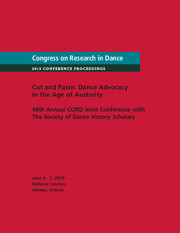No CrossRef data available.
Article contents
Mata Hari's Images of Femininity
Published online by Cambridge University Press: 04 January 2013
Abstract
The Dutch dancer Mata Hari (alias Margaretha Geertruida Zelle) has achieved an iconic status within twentieth-century dance history, partly due to her execution as a German spy in 1917. Although she lacked significant dance training, she successfully performed her works, primarily in eclectic oriental styles, before European audiences. My discussion considers Mata Hari's contributions against the backdrop of the pre–World War I European dance scene. It specifically explores the ideological and aesthetic framework within which she was embedded as a female artist in the context of related concurrent dance trends. Drawing on feminist theories, orientalism and postcolonialism (Edward Said), the paper examines how Mata Hari's on- and off-stage personae conformed to certain stereotyped images of women whilst also subverting social conventions.
- Type
- Research Article
- Information
- Congress on Research in Dance Conference Proceedings , Volume 40 , supplement S1: Dance Studies and Global Feminisms , 2008 , pp. 168 - 174
- Copyright
- Copyright © The Author(s) 2008


